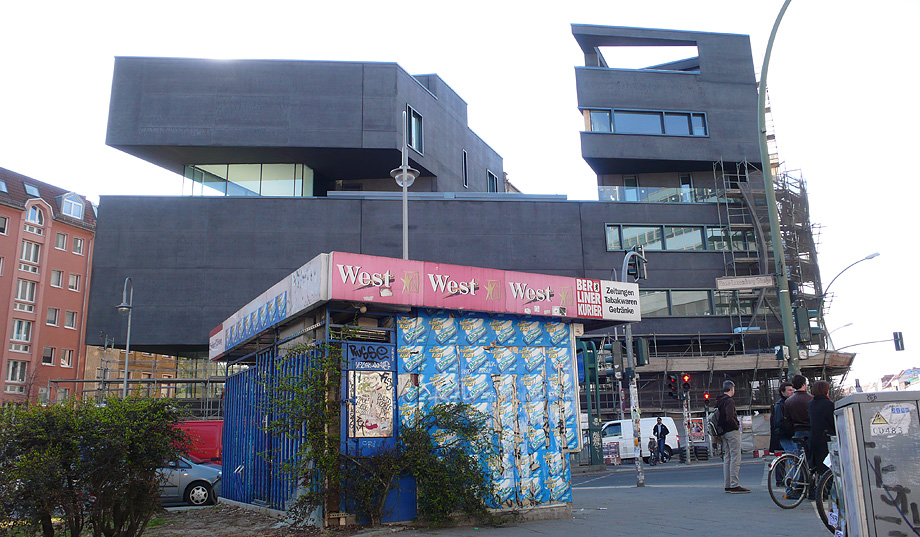On The Void, and Not Being There
Last night I would have been supporting my colleagues Oliver and Dan at an archi-shindig in Mitte were it not for a rotten, seasonal cold. The shindig in question was a lecture evening entitled “Void and it Value in Art and Life”, which marked the end of the exhibtion “Archeology of Hole – Creating an Archive”, curated by Marlena Kudlicka and Claudia Kugler. It’s the latest in a line of speaking engagements Slab’s attended, the last being the presentation of The New Death Strip last month, and it probably wouldn’t have been entirely decent to turn up and just sneeze at people. So I stayed home and drooled on the sofa.

Interestingly, last night’s event was held in L40. That’s not the name of some club or squat, but rather, the name of a new apartment building which went up on Rosa-Luxemburger Platz last year. I actually had the chance to tag along with a tour of the building with its architect Roger Bundschuh last year, a treat organised by Jim Hudson of Architecture in Berlin. We learnt some interesting things about the building that day: for example, that the entire structure rests on a layer of shock-absorbing, super-dense styrofoam blocks, which just sit on the foundations and aren’t actually ‘connected’ to them. The reason for this is the adjacent metro line and tram interchange: a source of metropolitain seismic activity. Seeing as the apartments will be sold to high-flying art collectors, and are designed more like the aristocratic long-galleries of yore, this probably makes good sense. The last thing you want, after stepping off the red-eye from the Art Basel Miami Beach, is to have your sleep robbed by the early morning M8 to Ahrensfelder rumbling by, throwing your Basquiat off the wall.

So I missed my chance to see the place actually finished and semi-functional. When I was there, part of the charm lay in the fact that this unabashed piece of modern design – looking so alien in the surrounding Hans Poelzig ensemble – was still in the process of unpeeling itself from a nest of scaffolding, protective foils and the rough felt floor coverings of the painters. Still, the interior geometry couldn’t hide the fact that this was a hard-edged piece of white-cube living in the making.
I haven’t caught up with my two colleagues yet to hear how the evening went, but our purpose there was to join the discussion about voids. Dan was planning on taking a surgical sledgehammer to the whole intellectual notion of the void by reminding the gathering that true voids don’t exist, and that they are a phenomena of perception governed by resolution. Oliver was going to approach the perceived emotional void in super-precise hi-tech architecture, and I was going to avoid the subject altogether (pun intended), by deviously skirting around the theme, and talking about the transformation and mediation of landscapes. All three angles were to be heavily informed by our field trip and resulting work on The New Death Strip.

One of my trips along the former Berlin Wall took me to the south-east of the city, where the district of Neukölln borders with the surrounding state of Brandenburg. It was here that I cycled into the middle of a landscaping project called ‘Am Dörferblick’, a park slated to open to the public in June 2011. It’s a part of the compensatory ecological measures being taken by the new Berlin Brandenburg International airport, currently under construction some kilometers to the south. The site was in wild disarray. Not a void, as such, but caught on this particular day in a state of suspended animation between two phases of being. There is a richness to the condition of incompletion which is unmatched by the finished artifact: a kind of taboo-aesthetic unarticulated in the design mainstream, and probably all the more seductive for its transience. This had once been the Death Strip, a militarised zone chemically stripped of vegetation, carpeted with sand and combed daily like some malignant Zen garden. Not a real void either, but an arcanely elaborate mechanism built to prevent trespassing.

The developer’s sign at Am Dörferblick was calling the project a “nature experience”, one of those dubious ad-land phrases which sound as though a crack team of Manhattan lawyers was on the creative team making sure that anything which sounds like a promise is sufficiently ambiguous not to stand up in court. I could just as easily call my breakfast a “breakfast experience”, and indeed I shall from now on, for my own private amusement. The sub-text though is easily deciphered: a nature experience is the experience of nature, but not neccesarily nature, which doesn’t need an experience to be exerienced. The “experience” is an imposed program, not quite a simulation, but close enough. Which is fine, because that’s what parks, historically, have always been about.
It just leaves to be noted though, amid all this vacuous phraseology (theirs, not mine), that the architect’s illustration of the future park includes human figures rendered as white silhouettes – little voids cut out of the landscape, implying life and activity, but still absent, not yet there.